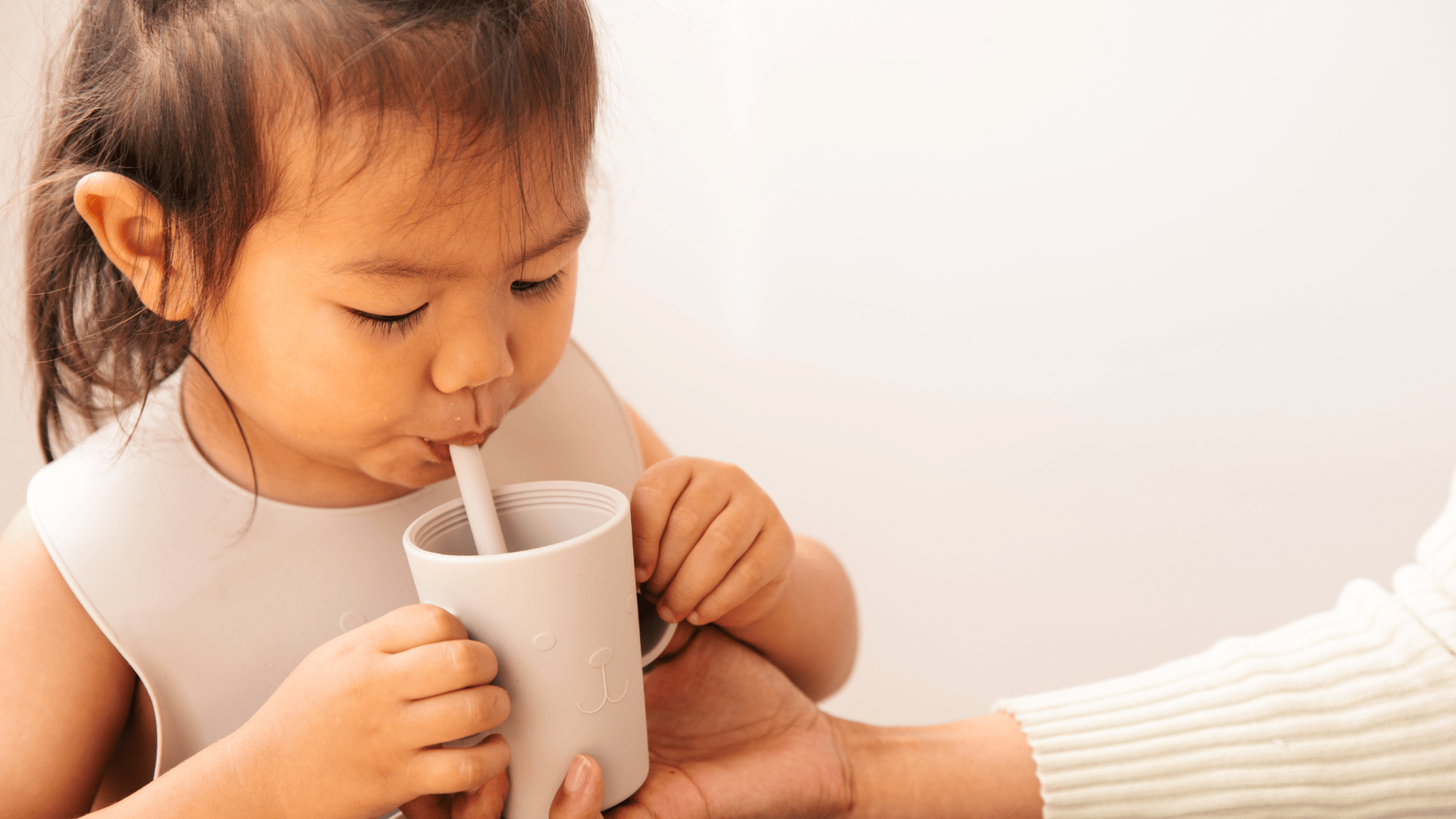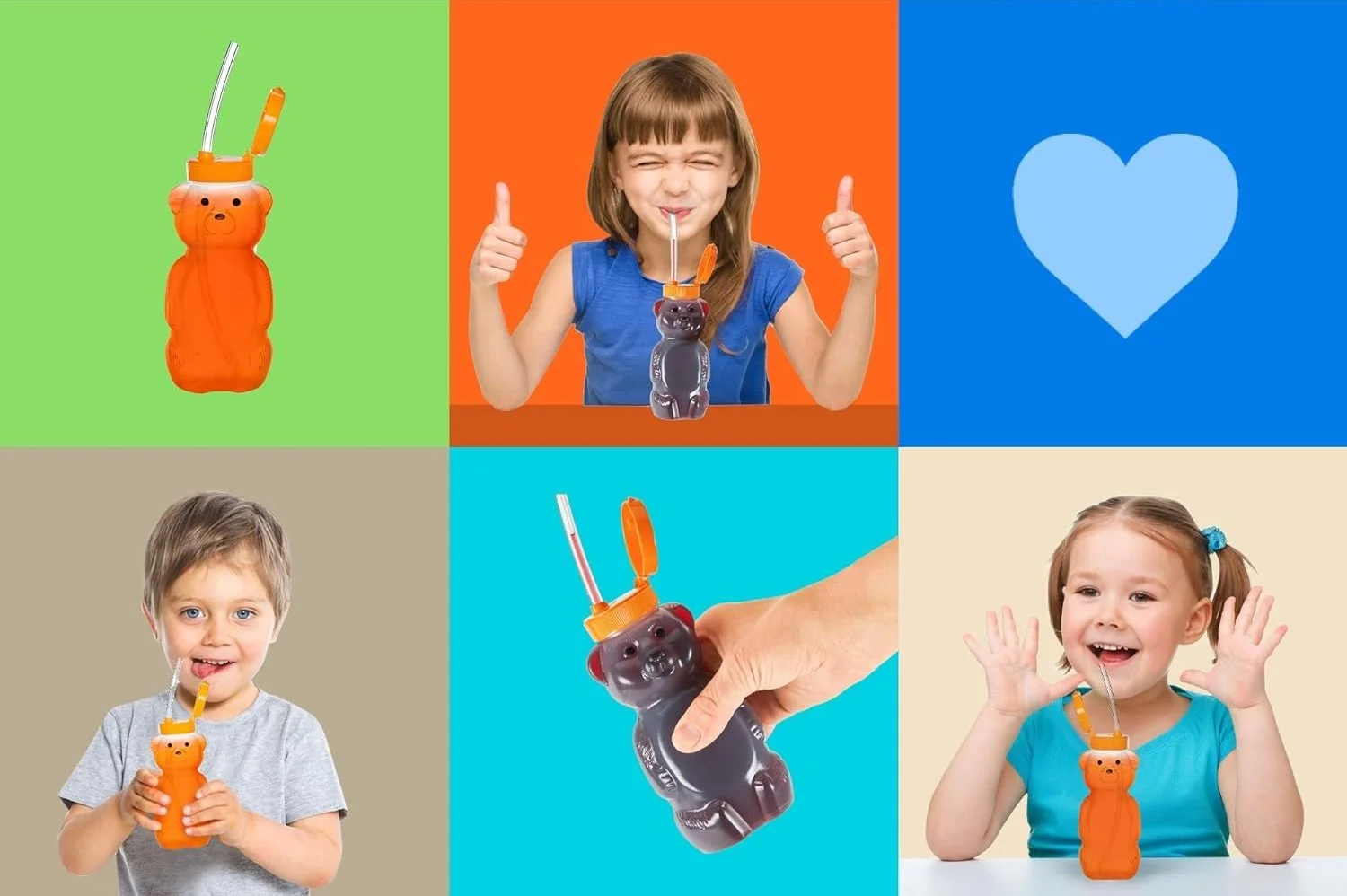How to Teach a Baby to Drink Through a Straw
This blog contains affiliate links, meaning that if you choose to purchase a product through a link, I will receive a small commission - this in no way impacts the amount you pay. Affiliate links are marked with an asterisk (*).
As your baby grows and begins to explore solid foods around 6 months of age, you may be wondering about when to start offering a straw cup. Or maybe you have already started offering an open cup, and your baby is struggling with the transition to a straw cup.
Learning to drink from a straw cup is an important milestone. Not only does it help develop babies' oral motor skills for speech and chewing, but it also opens up a world of independence when it comes to drinking. Drinking exclusively from a bottle or sippy cup can sometimes delay these skills, which are needed for eating and speaking.
As a pediatric dietitian specializing in infant feeding, I’ve helped countless babies learn to drink successfully through a straw cup in my private practice. In this post, we’ll work through the process of teaching your baby to drink from a straw, and I’ll give you several tips and tricks to ensure sipping success.
When should I introduce a straw cup to my baby?
Before diving into the teaching process, it's important to know when it's appropriate to introduce a straw to your baby. According to the American Academy of Pediatrics (AAP), most babies are developmentally ready to use an open cup starting early - at around six months of age (and sometimes even earlier!)
However, it is important to pay attention to your baby’s signs of readiness. These signs include sitting in a high chair independently, holding things (relatively) steadily with the hands, and having the ability to bring objects to the mouth with hands.
Remember, every baby is different, so if you aren’t sure your child is ready, consult with your pediatrician or dietitian for further assessment.
Some parents prefer to start with an open cup first and then move on to a straw cup after a month or two. It is also okay to introduce a straw cup while you are beginning training with an open cup. Either way, introducing a cup at around 6 months of age is best.
Which straw cup is best for my baby/toddler?
Choosing the right straw cup for your baby is important when it comes to having a successful start. Look for straw cups with a thin, short straw and no valve on the lid. Opt for BPA-free and dishwasher-safe options, such as the ezpz Mini Cup and Straw Training System* and Lollaland weighted straw cup*, to ensure safety and convenience for both you and your baby. Consider cups with handles for an easier grip, making it more manageable for your little one to hold and control.
For more specific recommendations, check out my favorites listed on my Amazon storefront*.
Tips for Teaching Straw Drinking to Babies
Babies are natural imitators, so before introducing the straw cup, demonstrate how to use it. Take a sip from the straw yourself, making exaggerated sounds like “ahhh” to pique their curiosity. Show enthusiasm and excitement to make it a fun experience!
Then, sit face-to-face with your baby, holding the cup in front of them. You can let the baby explore the cup, and they may place it on their lips by themselves. If not, you can gently guide the straw to their lips. Gradually bring the straw to the middle of their mouth and encourage them to suck by making a “fishy face.”
If you are having trouble getting your baby to sip, try this tip from my friend and colleague, certified speech-language pathologist Melanie Potock. In her post, she describes the process of siphoning a small amount of water or baby food puree into a straw, trapping it with your finger, and placing it on your baby’s lips to show them what is inside.
Many younger babies close to 6 months of age may grasp the concept quickly because they have a naturally strong sucking reflex. However, if your baby is learning to drink from a straw cup a little later, closer to 8-10 months, they may not grasp the concept initially. Try to be patient and offer praise and positive reinforcement for any progress they make.
If you are having trouble with these methods, you can opt for a squeezable straw cup (such as the Honey Bear training cup* or a take-and-toss cup). When your baby puts their mouth to the straw, gently squeeze the bottle to release the liquid and allow a tiny bit to enter their mouth.
How should I transition baby from a sippy cup to a straw cup?
If your baby is already accustomed to using a sippy cup, transitioning to a straw cup can be easy. Start by gradually replacing one of their sippy cups with a straw cup during mealtime.
Allow your baby time to explore the cup, put the straw to their lips, and experiment with it at their own pace. Encourage them to hold the cup and guide the straw to their mouth, especially if they are older and more independent. Initially, they may tilt the cup or chew on the straw, but this is a part of the learning process.
Be consistent in offering the straw cup during meals and gradually phase out the sippy cup until they are comfortable with the straw cup alone.
What if my baby chokes while straw-drinking or lets water run out of their mouth?
Some babies have a hard time controlling the liquid they are sucking from a straw, which can result in water dribbling from their mouth while drinking or choking if they try to swallow too much too quickly.
Try offering a straw that has a little more resistance and requires a stronger suck, such as a skinnier straw like a coffee stirrer. This can encourage your little one to squeeze their lips tighter around the straw to prevent water from coming out, and can also slow down the amount of liquid coming into their mouth at once.
You can also try offering thicker liquids such as a smoothie, kefir, a thinned-out baby food puree, or soup. Model an exaggerated “fish lips” mouth position as you show your baby how to have full closure of lips around the straw.
What if my baby refuses to drink from a straw cup?
If your baby isn’t quite getting the hang of the straw cup and they are between 6-8 months old, continue to offer it at mealtimes and model use, but do not stress if they aren’t there yet. Remember that babies need time to adjust and get acquainted with their new cup. They may bite or chew on the cup first or just pick up the cup and examine it. Keep the experience fun, and continue to practice with the open cup for water during meals.
If your baby is older than 9 months old and seems frustrated or upset when you offer the straw cup, try offering the cup in a different location, such as on a picnic blanket outside instead of at the kitchen table. Try playing a game, such as doing a “cheers!” to get your baby comfortable holding the cup, then model placing your mouth on the straw followed by saying “ahhh.”
Most babies are able to successfully use a straw cup by around 12 months of age if they start practicing at 6 months. If you are worried about your child’s inability to drink from a straw or open cup, follow up with your pediatrician or dietitian for further evaluation.
What if my baby isn’t learning to drink from a straw?
Learning to drink from a straw is a skill that requires practice and patience. Make it a regular part of your baby's routine, offering the straw cup during meal and snack times. Allow them to practice, even if it means spills and messes along the way.
Encourage independent sipping by gradually reducing assistance and letting them hold the cup on their own. Babies who approach their first birthday with some open and straw cup drinking skills in place tend to have an easier transition away from bottles, so it can help to get an early start.
If your baby gets frustrated or loses interest, take a break and try again later. Remember, every baby progresses at their own pace, so be patient and supportive throughout the learning process. Teaching your baby to drink from a straw is a rewarding experience that fosters independence and develops essential oral motor skills.
P.S. If you’re getting ready to start your baby on solids, or if your baby has recently begun his or her feeding journey and you need guidance on food sizing, balanced baby meals, and introducing the top allergenic foods to help prevent food allergies while starting solids, check out my new book!
A collection of family-friendly, baby-led weaning recipes that make it easy to keep common allergens in your baby’s diet regularly.







